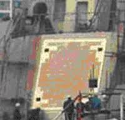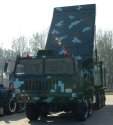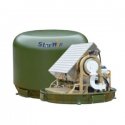Hi everyone. I would like to collect in this thread all the information we have on the Chinese "AEGIS", including radar systems, SAMs, data links, etc.
I will start with the overview of the core system, the Type 346 radar.
This is suspected to be a S-band AESA radar, with an octagonal antenna of about 4m diameter and antenna aperture of about 12.5m2. The AESA is built out of quad TRMs, with each quad capable of 100W peak RF power. Total number of quads is estimated to be 1250, for a total of 5000 T/R elements and 125kW peak RF per antenna. Antennae are air-cooled. Max instrumented range is about 450km. The S-band antenna is sandwiched between two C-band arrays. The function of the C-band arrays is to provide uplink/downlink communication with the principle weapon of the Chinese AEGIS: HHQ-9. Only known photo of the S-band/C-band antenna, taken from a type 052C being fitted out. Authenticity of this photo has not been verified.

Fan-made sketch of antennae layout:

Type 052D destroyers were built with what appears to be an updated version of the radar, dubbed Type 346A. The antennae are slightly larger, and the external shielding has a more square-like shape. This radar uses liquid cooling, which implies that the power output went up. The C-band missile uplink/downlink antennae are retained. Because of the higher topside weight of the larger, heavier radar and the enlarged VLS, the Type 052D has a 1m greater draft than 052C, which slightly reduces the radar horizon and increases susceptibility to water spray. A nice comparison photo:

The principal SAM of Chinese AEGIS is HHQ-9. The missile body appears to be ported from the land HQ-9 system, but the guidance system was a new design: it employs an active radar seeker. Range estimates for the first version on board Type 052C were anywhere between 90km to 150km. By virtue of using ARH the firepower of Type 052C and Type 052D ships is substantial: the number of targets that can be engaged simultaneously is only limited by the number of missiles onboard. ARH capability makes it theoretically possible to engage beyond the horizon targets. The fact that PLA Navy deployed an ARH only SAM in the early 2000s was quite a surprise. Latest versions of HHQ-9 are credited with a range of 200+ km and have secondary IR seekers. The latter is likely a backup in case the ARH mode is defeated by ECM/chaff/stealth.
Radars and SAMs are only a part of what makes AEGIS. The other equally important elements are data links and networking software. The American AEGIS makes it possible to fuse data from other ships and aircraft in real-time and present it on a single display onboard each AEGIS ship. The platform that fires a missile need not be the one that detected the target. It needs not even to track the target. Needless to say, this was revolutionary capability in the 80s.
Perhaps someone can fill in the details on Chinese data link and networking capabilities?
Another unknown is BMD. So far no indication that this capability is present has surfaced?
I will start with the overview of the core system, the Type 346 radar.
This is suspected to be a S-band AESA radar, with an octagonal antenna of about 4m diameter and antenna aperture of about 12.5m2. The AESA is built out of quad TRMs, with each quad capable of 100W peak RF power. Total number of quads is estimated to be 1250, for a total of 5000 T/R elements and 125kW peak RF per antenna. Antennae are air-cooled. Max instrumented range is about 450km. The S-band antenna is sandwiched between two C-band arrays. The function of the C-band arrays is to provide uplink/downlink communication with the principle weapon of the Chinese AEGIS: HHQ-9. Only known photo of the S-band/C-band antenna, taken from a type 052C being fitted out. Authenticity of this photo has not been verified.

Fan-made sketch of antennae layout:

Type 052D destroyers were built with what appears to be an updated version of the radar, dubbed Type 346A. The antennae are slightly larger, and the external shielding has a more square-like shape. This radar uses liquid cooling, which implies that the power output went up. The C-band missile uplink/downlink antennae are retained. Because of the higher topside weight of the larger, heavier radar and the enlarged VLS, the Type 052D has a 1m greater draft than 052C, which slightly reduces the radar horizon and increases susceptibility to water spray. A nice comparison photo:

The principal SAM of Chinese AEGIS is HHQ-9. The missile body appears to be ported from the land HQ-9 system, but the guidance system was a new design: it employs an active radar seeker. Range estimates for the first version on board Type 052C were anywhere between 90km to 150km. By virtue of using ARH the firepower of Type 052C and Type 052D ships is substantial: the number of targets that can be engaged simultaneously is only limited by the number of missiles onboard. ARH capability makes it theoretically possible to engage beyond the horizon targets. The fact that PLA Navy deployed an ARH only SAM in the early 2000s was quite a surprise. Latest versions of HHQ-9 are credited with a range of 200+ km and have secondary IR seekers. The latter is likely a backup in case the ARH mode is defeated by ECM/chaff/stealth.
Radars and SAMs are only a part of what makes AEGIS. The other equally important elements are data links and networking software. The American AEGIS makes it possible to fuse data from other ships and aircraft in real-time and present it on a single display onboard each AEGIS ship. The platform that fires a missile need not be the one that detected the target. It needs not even to track the target. Needless to say, this was revolutionary capability in the 80s.
Perhaps someone can fill in the details on Chinese data link and networking capabilities?
Another unknown is BMD. So far no indication that this capability is present has surfaced?






